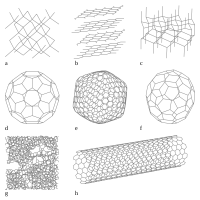
Photo from wikipedia
Graphitic carbon nitride (CN) suffers from rapid recombination of photoexcited charges due to the existed highly symmetrical tri-s-triazine ring and long charge diffusion path, resulting in its moderate photocatalytic activity.… Click to show full abstract
Graphitic carbon nitride (CN) suffers from rapid recombination of photoexcited charges due to the existed highly symmetrical tri-s-triazine ring and long charge diffusion path, resulting in its moderate photocatalytic activity. The bridged phenyl embedded in CN structure was used to reduce the symmetry of tri-s-triazine ring. Besides, CN material was constructed with porous and hollow sphere structure in order to shorten the diffusion path of charge carriers. Herein, a simply thermal polymerization of trimesic acid doped melamine-cyanuric acid (MCA) supramolecular was employed to construct phenyl bridged graphitic carbon nitride (Ph-CN-MCA) with hollow sphere structure composed of porous nanosheets for visible-light catalytic H2 evolution. The porous and hollow sphere structured Ph-CN-MCA possessed the increased degree of polymerization, more negative conduction band potential, the enlarged BET surface area and the shortened charges diffusion path. In addition, bridged phenyl embedded in the Ph-CN-MCA structure not only accelerated the dissociation of photogenerated carriers but also narrowed the band gap and extended the visible light absorption. Further, the separated HOMO and LUMO of Ph-CN-MCA facilitated the spatial dissociation of photogenerated charges, which was also confirmed by theoretical calculation. As a consequence, compared with the reference CN-MA catalyst prepared from melamine, Ph-CN-MCA showed approximately 48.42 times of photocatalytic H2 evolution under visible light irradiation. This developed synthetic method herein highlights that phenyl bridged graphitic carbon nitride with porous and hollow sphere structure could provide an efficient platform to boost dissociation of photoexcited charge carriers and photocatalytic H2 evolution.
Journal Title: ACS applied materials & interfaces
Year Published: 2020
Link to full text (if available)
Share on Social Media: Sign Up to like & get
recommendations!